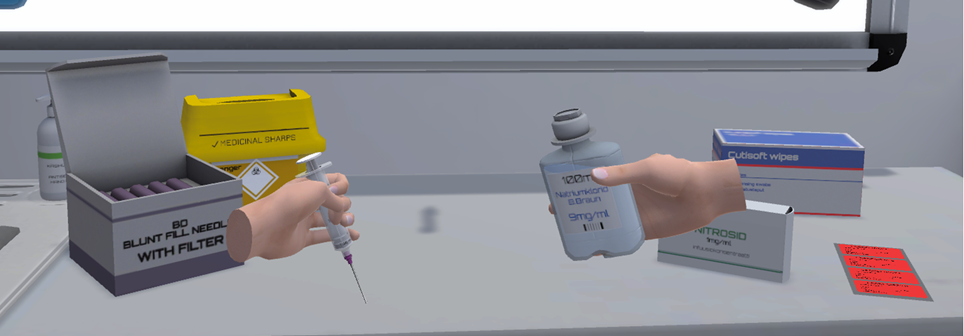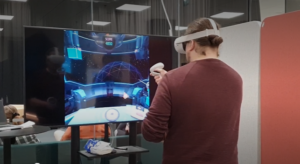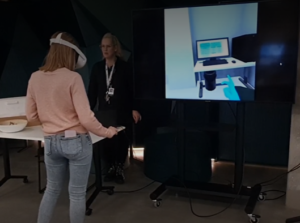XR-games are coming to teaching in Turku UAS

In this article we intend to introduce you to the concepts of extended reality, the practical matters of these technologies and the benefits that extended reality can bring to the modern education. Giving examples and studying the phenomenon of extended reality in the educational process, we will rely on the experience of interaction with PedaXR-project.
PedaXR-project is a project funded by the Ministry of Education and Culture and develops XR-technologies in education. The project develops XR-teaching games, improves teachers’ knowledge about XR-techniques and pedagogy and develops network co-operation between XR-actors e.g. educational institutions and companies.
At Turku UAS the development work is located in the field of Health and well-being. More than 300 Turku UAS nurse-, socionom- and physiotherapist- and occupational therapy students pilot the games during autumn 2022 and spring 2023.
Different XR-possibilities
Extended reality (XR) is the umbrella term for a spectrum of immersive and interactive technologies. It encompasses augmented reality (AR), mixed reality (MR), and virtual reality (VR). You can access XR through mobile devices, VR headsets and glasses, and other technologies.
Virtual reality (VR), the use of computer modeling and simulation that enables a person to interact with an artificial three-dimensional (3D) visual or other sensory environment. VR – applications immerse the user in a computer-generated environment that simulates reality through the use of interactive devices, which send and receive information and are worn as goggles, headsets, gloves, or body suits.

In a typical VR- format, a user wearing a helmet with a stereoscopic screen views animated images of a simulated environment. The illusion of “being there” (telepresence) is effected by motion sensors that pick up the user’s movements and adjust the view on the screen accordingly, usually in real time (the instant the user’s movement takes place). Thus, a user can tour a simulated suite of rooms, experiencing changing viewpoints and perspectives that are convincingly related to his own head turnings and steps. Wearing data gloves equipped with force-feedback devices that provide the sensation of touch, the user can even pick up and manipulate objects that he sees in the virtual environment.
So, we can sumerise:
- Extended Reality (XR) refers to all real-and-virtual environments generated by computer technology and wearables. The ‘X’ in XR is a variable that can stand for any letter.
- Virtual Reality (VR) encompasses all immersive experiences. These could be created using purely real-world content (360 Video), purely synthetic content (Computer Generated), or a hybrid of both.
- Augmented Reality (AR) is an overlay of computer generated content on the real world that can superficially interact with the environment in real-time. With AR, there is no occlusion between CG content and the real-world.
- Mixed Reality (MR) is an overlay of synthetic content that is anchored to and interacts with objects in the real world—in real time. Mixed Reality experiences exhibit occlusion, in that the computer-generated objects are visibly obscured by objects in the physical environment.
Why to use XR-games in teaching?
XR can be used in a variety of disciplines, from teacher education to medical training and foreign language immersion. Nurse students can use VR to practice procedures before they feel confident trying them in real life (for example practice blood transfusion). Foreign language students can gain language learning experiences without having to travel to another country.
The main findings in the researches is that XR- games may not be superior to other teaching methods regarding direct learning outcomes, but a clear indication towards improved indirect learning outcomes (learning motivation, engagement) was detected. Based on the results it seems that XR-games are more supportive of learning motivation and engagement than more traditional learning environments.
XR-games are more supportive of learning motivation and engagement than more traditional learning environments.
Immersive XR training experiences, such those ones by PedaXR are perfect for industries that are high-stress or dangerous — particularly for situations in which it is crucial to be prepared, but difficult or expensive to replicate the scenarios that will be faced in the real-world. VR Nursing game was created for such cases. Extended reality provides practice reps in a realistic virtual environment that translates into sharpened skills in the real-world. PedaXR VR Nursing game, designed to give students the opportunity to learn blood transfer process, to work out the mechanism of action in case of bleeding, in a safe and at the same time as realistic as possible way was created for such cases.
Hence we can state extended reality provides practice reps in a realistic virtual environment that translates into sharpened skills in the real-world.
Students’ experiences
As mentioned before, several of Turku UAS students have already piloting experiences about XR-games. We took part to some piloting sessions and asked students about their opinions.
The games used in the piloting sessions we took part were nitro infusion and blood transfusion and the students were nurse students. In the nitro infusion simulation, the students had to proceed step by step in the treatment situation according to the correct protocol. For example, the students had to follow aseptic technique, otherwise they could not advance to the next step in the simulation. This ensures that the students perform the practiced nursing situation correctly.

For the students, the use of VR headsets was mostly new in piloting, and only a few had previous experience with it. Many students said that after instructions and a little getting used to, the use of VR glasses started to take shape by itself. Many felt that help and guidance were important at the beginning.
The use of VR-glasses for educational purposes was considered to be profitable in the future. Getting used to the virtual world took a little while, because moving there, grasping things and implementing the game’s instructions seemed challenging at first. Especially the most challenges appeared in the game where the purpose was to insert the cannula into the patient.
The biggest challenge in the game was to grab the things and get them in their right places. Most of the students described the virtual teaching environment and moving there as challenging and awkward, but still meaningful.
Anyway students felt that experimenting with new technology was meaningful and brought a change to traditional study techniques and practices. In addition, success in the piloting was a motivating experience for many students and adds positivity to learning.
Authors:
Nea Euren
Social services student
Turku UAS
Jouko Erkkilä
Social services student
Turku UAS
Artturi Jyrkkänen
Social services student
Turku UAS
Yelyzaveta Balan
Exchange student
Turku UAS
Tinja Väinämö
Social services student
Turku UAS
Tiina Laakso
Lecturer in Social Services and Education
Turku UAS
References:
Franklin Institute. What is extended reality (XR)? www.fi.edu/tech/what-is-extended-reality (2020).
Lee H-G, Chung S, Lee W-H. Presence in virtual golf simulators: The effects of presence on perceived enjoyment, perceived value, and behavioral intention. New Media Soc 2013;15:930–46.
Marr B. What is extended reality technology? A simple explanation for anyone. Forbes, 12 August 2019. www.forbes.com/sites/bernardmarr/2019/08/12/what-is-extended-reality-technology-a-simple-explanation-for-anyone/.Google
Suh A, Prophet J. The state of immersive technology research: a literature analysis. Comput Hum Behav 2018;86:77–90.
What is AR, VR, MR, XR, 360? https://unity3d.com/what-is-xr-glossary.Google
